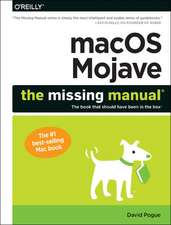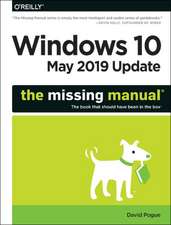Classical Music For Dummies
Autor David Pogue, Scott Specken Limba Engleză Paperback – 2 mar 2022
Preț: 111.62 lei
Nou
Puncte Express: 167
Preț estimativ în valută:
21.36€ • 23.19$ • 17.94£
21.36€ • 23.19$ • 17.94£
Carte disponibilă
Livrare economică 02-16 aprilie
Livrare express 18-22 martie pentru 30.54 lei
Preluare comenzi: 021 569.72.76
Specificații
ISBN-13: 9781119847748
ISBN-10: 1119847745
Pagini: 384
Dimensiuni: 192 x 232 x 22 mm
Greutate: 0.5 kg
Ediția:3rd Edition
Editura: Wiley
Locul publicării:Hoboken, United States
ISBN-10: 1119847745
Pagini: 384
Dimensiuni: 192 x 232 x 22 mm
Greutate: 0.5 kg
Ediția:3rd Edition
Editura: Wiley
Locul publicării:Hoboken, United States
Notă biografică
David Pogue is a six-time Emmy-winning "CBS Sunday Morning" correspondent, a New York Times bestselling author, and a former Broadway conductor and arranger. Scott Speck is an internationally acclaimed conductor and author who has delighted audiences in London, Paris, Moscow, Beijing, New York, Chicago, Los Angeles, and countless other cities.
Cuprins
Introduction 1
About This Book 1
Foolish Assumptions 2
Icons Used in This Book 2
Beyond the Book 3
Where to Go from Here 4
Part 1: Getting Started With Classical Music 5
Chapter 1: Prying Open the Classical Music Oyster 7
Discovering What Classical Music Really is 8
Figuring Out What You Like 8
The Seven Habits of Highly Effective Composers 9
Their music is from the heart 9
They use a structure that you can feel 9
They're creative and original 10
They express a relevant human emotion 10
They keep your attention with variety and pacing 11
Their music is easy to remember 11
They move you with their creations 12
Chapter 2: The Entire History of Music in 80 Pages 13
Understanding How Classical Music Got Started 13
Chanting All Day: The Middle Ages 14
Gregorian chant 14
A monk named Guido 15
Mass dismissed! 15
The First Composer-Saint 16
Born Again: The Renaissance 16
The madrigal takes off 16
Opera hits prime time 17
Getting Emotional: The Baroque Era 18
Renegade notes on wheels 18
Kings, churches, and other high rollers 19
Antonio Vivaldi 19
George Frideric Handel 21
Johann Sebastian Bach 24
Tightening the Corset: The Classical Style 26
Joseph Haydn 27
Wolfgang Amadeus Mozart 29
Joseph Boulogne, Chevalier de Saint-Georges 34
Ludwig van Beethoven: The man who changed everything 34
Schubert and his Lieder 39
Felix Mendelssohn 42
Fanny Mendelssohn 44
Falling in Love: Hopeless Romantics 45
Carl Maria von Weber 45
Hector Berlioz 46
Frédéric Chopin 49
Robert Schumann 51
Johannes Brahms 54
The superstars: Paganini and Liszt 56
Liszt follows Paganini's lead 57
Richard Wagner 58
Strauss and Mahler 59
Saluting the Flag(s): Nationalism in Classical Music 63
BedYich Smetana 64
Antonín DvoYák 65
Edvard Grieg 67
Jean Sibelius 68
Carl Nielsen 70
Glinka and the Mighty Fistful 71
Peter Tchaikovsky 73
Sergei Rachmaninoff 75
Listening to Music of the 20th Century and Beyond 77
Debussy and Ravel 78
Igor Stravinsky 80
Sergei Prokofiev 83
Dmitri Shostakovich 84
The Second Viennese School 86
The Americans 87
Chapter 3: Spotting a Sonata 95
Symphonies 95
First movement: brisk and lively 96
Second movement: slow and lyrical 97
Third movement: dancy 98
Finale: rollicking 98
Sonatas and Sonatinas 99
Concertos 100
Concerto structure 101
The cadenza 101
Dances and Suites 103
Serenades and Divertimentos 104
Themes and Variations 105
Fantasias and Rhapsodies 106
Tone Poems (Or Symphonic Poems) 107
Lieder (and Follower) 107
Leader of the Lieder 108
Song forms 108
Oratorios and Other Choral Works 109
Operas, Operettas, and Arias 110
Overtures and Preludes 110
Ballets and Ballerinas 111
String Quartets and Other Motley Assortments 112
Why Do You Need a Form, Anyway? 113
Part 2: Listen Up! 115
Chapter 4: Dave 'n' Scott's E-Z Concert Survival Guide(TM) 117
Preparing -- or Not 117
Knowing When to Arrive at the Concert 118
Can I Wear a Loincloth to The Rite of Spring? 119
The Gourmet Guide to Pre-Concert Dining 119
Figuring Out Where to Sit -- and How to Get the Best Ticket Deals 120
To Clap or Not to Clap: That's the Question 122
Why nobody claps 122
More on the insane "no-clap" policy 123
Who to Bring and Who to Leave at Home with the Dog 125
Recognizing Which Concerts to Attend -- or Avoid -- on a Date 125
Peeking at the Concert Program 126
The typical concert format 127
The music itself 129
A different kind of program 130
Introducing the Concertmaster 132
Finding the pitch 133
Twisting and turning, pulling and pushing 133
Enter the Conductor 135
Understanding interpretation 135
Slicing up time 137
Reading the job description 138
Chapter 5: For Your Listening Pleasure 141
1 Handel: Water Music Suite No 2: Alla Hornpipe 142
2 Bach: Well-Tempered Clavier, Book 2: Prelude and Fugue in C Major 143
3 Mozart: Piano Concerto No 22 in E-Flat, Third Movement 145
4 Beethoven: Symphony No 5, First Movement 149
Exposition 150
Development 151
Recapitulation 151
Coda 152
5 Brahms: Symphony No 4, Third Movement 153
6 DvoYák: Serenade for Strings, Fourth Movement 155
7 Tchaikovsky: Symphony No 6, Fourth Movement 156
8 Debussy: La Mer: Dialogue du Vent et de la Mer 158
9 Stravinsky: The Rite of Spring: Opening to the End of Jeu de Rapt 161
Introduction 161
Danses des adolescentes (Dances of the Adolescent Girls) 162
Jeu de rapt (Ritual of Abduction) 163
Intermission: Backstage Tour 165
Living in the Orchestral Fishpond 165
What I Did for Love 166
Going through an Audition 167
An almost-true story 167
Rigged auditions 169
The list 169
The prescription 170
Playing the odds 170
An unexpected meeting 171
The return 171
Onstage 172
Behind the screen 172
The wait 174
The aftermath 175
The Life of an Orchestra Musician, or What's Going on in the Practice Room? 175
Selling the Product 176
Understanding Contract Riders 179
The Strange and Perilous Relationship between an Orchestra and Its Conductor 180
Why an Orchestra Career is Worth the Grief 182
Part 3: A Field Guide To The Orchestra 183
Chapter 6: Keyboards & Co 185
The Piano 185
Looking inside the piano 186
Naming the notes 186
Finding an octave 186
Playing the black keys 187
Looking inside the piano 188
Pressing down the pedals 188
Hearing the piano 190
The Harpsichord 191
Winning the Baroque gold medal 191
Hearing the harpsichord 192
The Organ 193
Pulling out the stops 194
Hearing the organ 194
The Synthesizer 195
Chapter 7: Strings Attached 197
The Violin 198
Drawing the bow 199
Tuning up 199
Playing the violin 200
Vibrating the string 201
The unbearable lightness of bowing 201
Plucking the strings 202
Hearing the violin 203
The Other String Instruments 204
The viola 204
The cello 206
The double bass 208
The harp 209
The guitar 212
Chapter 8: Gone with the Woodwinds 215
The Flute 216
Making music out of thin air 216
Hearing the flute 217
The Piccolo 218
The Oboe 219
Playing the oboe 221
Hearing the oboe 222
The English Horn 223
The Clarinet 223
Transposing instruments 223
Hearing the clarinet 225
The Saxophone 226
The Bassoon 227
Chapter 9: The Top (and Bottom) Brass 231
Making a Sound on a Brass Instrument 232
The French Horn 233
Hunting for notes: The natural horn 234
Adding valves: The modern, treacherous horn 234
Hearing the French horn 235
The Trumpet 236
Tonguing 237
Using mutes 237
Hearing the trumpet 237
The Trombone 238
Sliding around 239
Hearing the trombone 240
The Tuba 241
A gaggle of tubas 241
Hearing the tuba 242
Pet Peeves of the Brassily Inclined 242
Chapter 10: Percussion's Greatest Hits 243
The Timpani 244
Drum roll, please! 246
Hearing the timpani 246
The Bass Drum 246
The Cymbals 247
The Snare Drum 247
The Xylophone 248
Other Xylo-like Instruments 250
More Neat Instruments Worth Banging 250
The triangle 250
The tambourine 252
The tam-tam and gong 253
The castanets 254
The whip 254
The cowbell 255
The ratchet 255
Part 4: Peeking Into The Composer's Brain 257
Chapter 11: The Dreaded Music Theory Chapter 259
I've Got Rhythm: The Engine of Music 260
Dividing up time 260
Feeling the beat 261
Sight-reading for the first time 262
Making notes longer 263
Making notes shorter 264
Adding a dot 265
Taking the final exam 266
Understanding Pitch: Beethoven at 5,000 rpm 267
Performing an experiment for the betterment of mankind 268
12 pitches! 269
Notating pitches 270
Dave 'n' Scott's 99.9999% Key-Determining Method 278
Why we have keys 279
Making the Leap into Intervals 280
The major second 281
The major third 282
The fourth 282
The fifth 283
The major sixth 284
The major seventh 285
The octave 285
Telling the difference: major and minor intervals 286
The minor second 286
The minor third 287
The minor fifth (not!) -- aka the tritone 288
The minor sixth 288
The minor seventh 289
Getting on the Scale 290
Constructing a Melody 292
Getting Two-Dimensional: Piece and Harmony 292
Major, minor, and insignificant chords 293
Friends and relations: harmonic progressions 294
Friends, Romans, chord progressions 295
Listening to the oldies 296
Put in Blender, Mix Well 297
Getting Your Music Theory Degree 298
Chapter 12: Once More, with Feeling: Tempo, Dynamics, and Orchestration 299
Meet the Dynamics Duo: Soft and Loud 300
Honey, I shrunk the LoudSoft(TM) 301
Wearing Italian hairpins 302
Getting into matters of sonic taste 303
Throwing Tempo Tantrums 303
Telling 'Bones from Heckelphones: Orchestration Made Easy 304
Playing with sound colors 304
Notating orchestrations 304
Who's the orchestrator? 305
Part 5: The Part of Tens 307
Chapter 13: The Ten Most Common Misconceptions about Classical Music 309
Classical Music is Boring 309
Classical Music is for Snobs 310
All Modern Concert Music is Hard to Listen to 310
They Don't Write Classical Music Anymore 311
You Have to Dress Up to Go to the Symphony 311
If You Haven't Heard of the Guest Artist, She Can't Be Any Good 311
Professional Musicians Have It Easy 312
The Best Seats Are Down Front 313
Clapping between Movements is Illegal, Immoral, and Fattening 313
Classical Music Can't Change Your Life 314
Chapter 14: The Ten Best Musical Terms for Cocktail Parties 315
Atonal 316
Cadenza 316
Concerto 317
Counterpoint 317
Crescendo 317
Exposition 318
Intonation 318
Orchestration 318
Repertoire 318
Rubato 318
Tempo 319
Using Your New-Found Mastery 319
Chapter 15: Ten Great Classical Music Jokes 321
Master of Them All 321
The Heavenly Philharmonic 322
Brass Dates 322
The Late Maestro 323
Basses Take a Breather 323
Houseless Violist 324
Ludwig's Grave 324
The Weeping Violist 324
Musicians' Revenge 325
One Last Viola Joke 325
Chapter 16: Ten Ways to Get More Music in Your Life 327
Get Involved with Your Orchestra 327
Join a Classical Music Tour 328
Meet the Artists -- Be a Groupie 328
Make Music Friends on the Internet 329
Join an Unlimited Music Service 330
Listen to Your Local Classical Station 330
Load Up on Your Own Recordings 331
Watch Classical Music Movies 332
Study Up on the Classics 333
Make Your Own Music 334
Part 6: The Appendixes 337
Appendix A: Listen to This! Starting a Classical Music Collection 339
List 1: Old Favorites 340
List 2: MILD on the Taste Meter 341
List 3: MEDIUM on the Taste Meter 342
List 4: MEDIUM HOT on the Taste Meter 343
List 5: HOT on the Taste Meter 344
Appendix B: Classical Music Timeline 345
Appendix C: Glossary 353
Index 359








